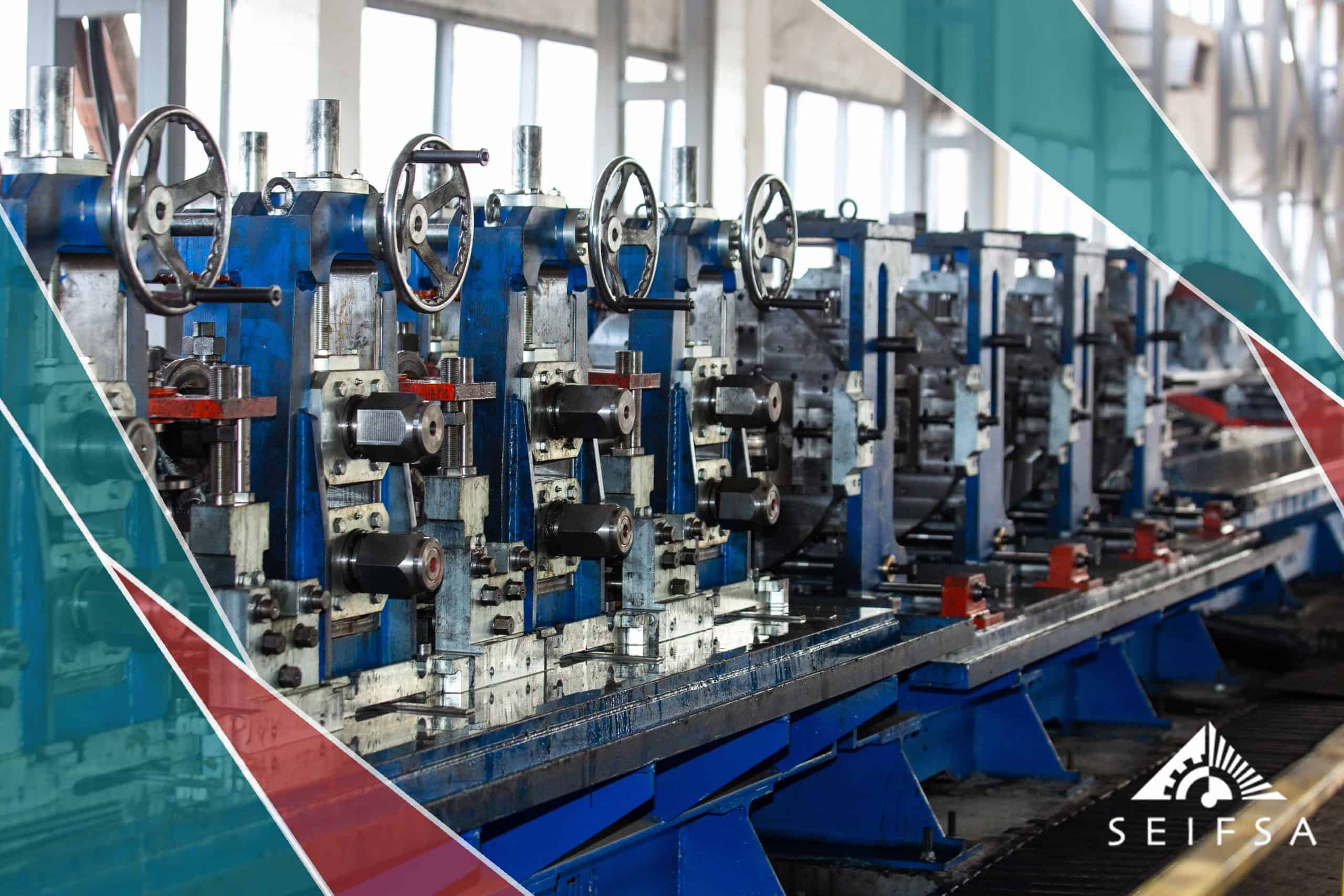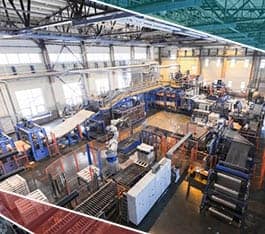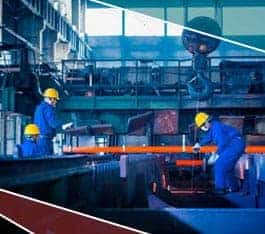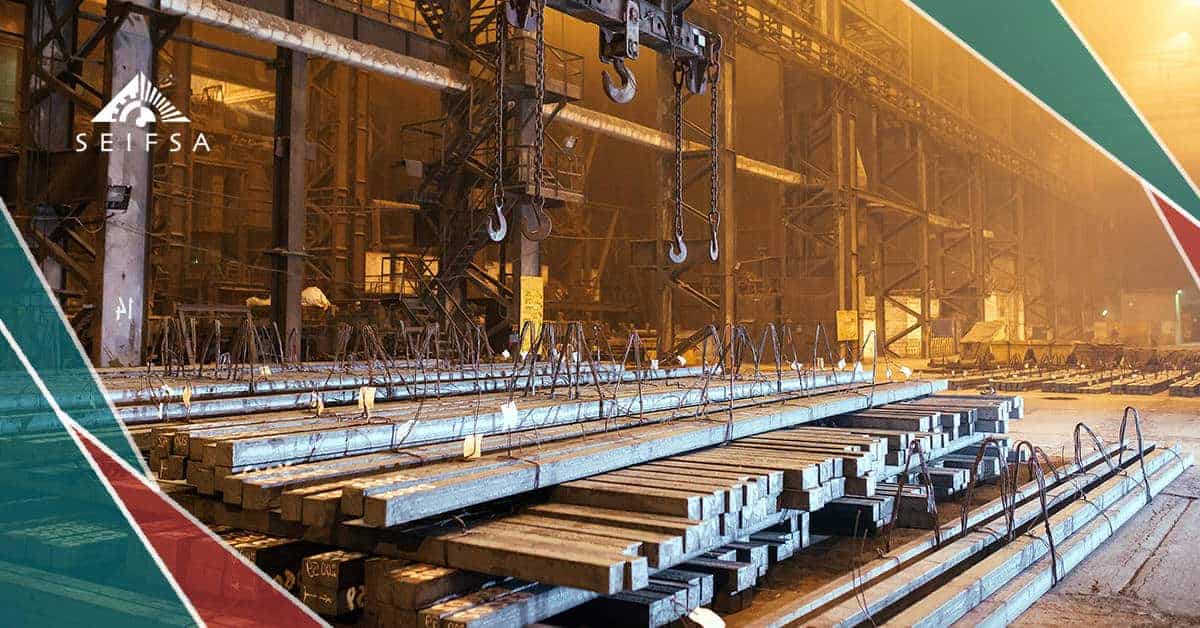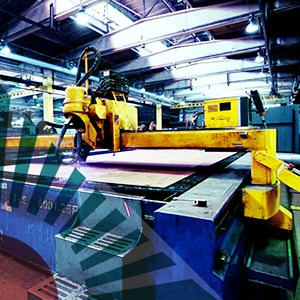Worrying Times for Local Manufacturing Sector as Production Declines Massively in 2020 Says SEIFSA
JOHANNESBURG, 11 FEBRUARY 2021 – The COVID-19 pandemic and the lockdown conditions which it occasioned had a devastating effect on the South African economy in general and the manufacturing sector in particular in 2020, Steel and Engineering Industries Federation of Southern Africa (SEIFSA) Chief Economist Chifipa Mhango said today.
Speaking after the release of the latest economic data by Statistics South Africa (Stats SA), which showed that manufacturing production fell by 11% and total sales declined by 9,9% in 2020 when compared to the previous year, Mr Mhango said the Stats SA data revealed the pressure under which companies within the Metals and Engineering (M&E) sector operated: total M&E production across the 13 sub-categories declined by 13.6% in 2020 when compared to 2019, and total sales declined by 12.3% to reach R727-billion. The largest sales value for the year was in the non-ferrous metal products sub-sector at R162-billion.
Mr Mhango pointed out that the M&E sector represents 29% of the South African manufacturing base, and that its decline has massive implications for other sectors of the economy such as construction, into which 60% of its products feed as key inputs. He noted that in 2020 the local economy experienced shortages of several key products used by the construction sector due to industries operating below the prescribed capacity.
“Indeed, there was shortage of steel as construction activity resumed and as other manufacturers that rely on steel in production also resumed operations,” he said.
Mr Mhango said SEIFSA was also concerned about the latest figures on capacity utilisation. According to Stats SA, in 2020 total capacity utilisation in the manufacturing sector was 72.3%, 1.8% down from the 81% in 2019. Within the M&E sector, average total capacity utilisation in 2020 was 67.6%, with the lowest level recorded in the other transport equipment sub-sector, at 58.4%, and the basic iron and steel sub-sector, at 54.2%. He said these figures explained the shortages of steel experienced in the country.
The South African economy is estimated to have contracted by 7.5% in 2020, partially due to the weak manufacturing production trends throughout the year, as a result of low capacity utilisation at producing companies under stringent COVID-19 lockdown regulations.
Mr Mhango said it was important for the Government to do more to revive the ailing economy, with special focus on speeding up implementation of policies.
“At SEIFSA, we want to see the finalisation and speedy implementation of the Steel Master Plan, which we believe will benefit both primary and downstream players in the local steel industry – this will be key to ensuring the M&E sector’s survival,” he said.
Mr Mhango said fixed investment was also key to reviving the M&E industry. He said South Africa’s level of gross fixed investment to total GDP needed to move to levels of above 40%, from below 20% at present, in order to grow the country’s industrial base.
Mr Mhango said although the Government had committed, during the 2020 national budget speech, to spending R815-billion over the next three years on various infrastructure projects, mainly though State-Owned Entities (SOEs), implementation was slow.
He said the M&E sector is heavily reliant on demand from key Government projects to boost its production and sales, especially for products such as steel and other related downstream products such as roofing material. He said the lack of progress in the implementation of such key Government projects was a hindrance to reviving the economy.
“As we await the tabling of the National Budget in Parliament on 24 February 2021, we expect tough statements in dealing with mismanagement of funds at SOEs and speeding up of reforms, coupled with increased investment incentives for the manufacturing sector, for both small and large businesses. More also needs to be done to revive the railway system that is not supporting industrial activity transportation, which was a commitment made by Government in a previous State of the Nation address,” he said.
Issued by:
Mpho Lukoto
Communications Manager
Tel: (011) 298 9411 / 082 602 1725
Email: mpho@seifsa.co.za
Web: www.seifsa.co.za
Massive decline in 2020 manufacturing sector production a major concern, says SEIFSA
JOHANNESBURG, 11 FEBRUARY 2021 – The COVID-19 pandemic and the lockdown conditions which it occasioned had a devastating effect on the South African economy in general and the manufacturing sector in particular in 2020, Steel and Engineering Industries Federation of Southern Africa (SEIFSA) Chief Economist Chifipa Mhango said today.
Speaking after the release of the latest economic data by Statistics South Africa (Stats SA), which showed that manufacturing production fell by 11% and total sales declined by 9,9% in 2020 when compared to the previous year, Mr Mhango said the Stats SA data revealed the pressure under which companies within the Metals and Engineering (M&E) sector operated: total M&E production across the 13 sub-categories declined by 13.6% in 2020 when compared to 2019, and total sales declined by 12.3% to reach R727-billion. The largest sales value for the year was in the non-ferrous metal products sub-sector at R162-billion.
Mr Mhango pointed out that the M&E sector represents 29% of the South African manufacturing base, and that its decline has massive implications for other sectors of the economy such as construction, into which 60% of its products feed as key inputs. He noted that in 2020 the local economy experienced shortages of several key products used by the construction sector due to industries operating below the prescribed capacity.
“Indeed, there was shortage of steel as construction activity resumed and as other manufacturers that rely on steel in production also resumed operations,” he said.
Mr Mhango said SEIFSA was also concerned about the latest figures on capacity utilisation. According to Stats SA, in 2020 total capacity utilisation in the manufacturing sector was 72.3%, 1.8% down from the 81% in 2019. Within the M&E sector, average total capacity utilisation in 2020 was 67.6%, with the lowest level recorded in the other transport equipment sub-sector, at 58.4%, and the basic iron and steel sub-sector, at 54.2%. He said these figures explained the shortages of steel experienced in the country.
The South African economy is estimated to have contracted by 7.5% in 2020, partially due to the weak manufacturing production trends throughout the year, as a result of low capacity utilisation at producing companies under stringent COVID-19 lockdown regulations.
Mr Mhango said it was important for the Government to do more to revive the ailing economy, with special focus on speeding up implementation of policies.
“At SEIFSA, we want to see the finalisation and speedy implementation of the Steel Master Plan, which we believe will benefit both primary and downstream players in the local steel industry – this will be key to ensuring the M&E sector’s survival,” he said.
Mr Mhango said fixed investment was also key to reviving the M&E industry. He said South Africa’s level of gross fixed investment to total GDP needed to move to levels of above 40%, from below 20% at present, in order to grow the country’s industrial base.
Mr Mhango said although the Government had committed, during the 2020 national budget speech, to spending R815-billion over the next three years on various infrastructure projects, mainly though State-Owned Entities (SOEs), implementation was slow.
He said the M&E sector is heavily reliant on demand from key Government projects to boost its production and sales, especially for products such as steel and other related downstream products such as roofing material. He said the lack of progress in the implementation of such key Government projects was a hindrance to reviving the economy.
“As we await the tabling of the National Budget in Parliament on 24 February 2021, we expect tough statements in dealing with mismanagement of funds at SOEs and speeding up of reforms, coupled with increased investment incentives for the manufacturing sector, for both small and large businesses. More also needs to be done to revive the railway system that is not supporting industrial activity transportation, which was a commitment made by Government in a previous State of the Nation address,” he said.
Oxygen Shortage Amid COVID-19 Second Wave Has Affected Industrial Production SEIFSA Poll Finds
JOHANNESBURG, 4 FEBRUARY 2021 – The impact of COVID-19 has had a significant negative impact on businesses across all sectors and taken a toll on healthcare systems and facilities in South Africa. In recent weeks, there have been news reports of a high demand for medical oxygen, putting immense pressure on oxygen suppliers and affecting industrial supply.
In an attempt to assess the scale of the oxygen shortage, the Steel and Engineering Federation of South Africa (SEIFSA), surveyed its member companies to investigate companies establish their experiences around oxygen shortage within the metals and engineering (M&E) sector and to understand the impact of the shortage on their production levels and whether alternative supplies were being sought regarding input supply chains.
According to the survey results, which were sent to all 1,600 companies that are members of SEIFSA through its affiliated Associations, 76.92% of the respondents said they had experienced oxygen shortages and had considered alternative supplies in the process.
Several companies whose analytical instruments use oxygen had to alter their inspection regularly to reduce consumption and find alternative supply, in one case at a cost of R4,000 per bottle versus the standard cost of R140 per bottle. Some of the respondents mentioned that they were at risk of running out of oxygen within 14 days. Others said the impact had been so severe that they had had to apply for extensions on their projects or stop production altogether.
“Based on the views of the respondents, SEIFSA is of the view that the oxygen shortage has, indeed, disrupted industrial production. However, we concur with our respondents who believe that lives need to be saved, hence the supply of medical oxygen should be prioritised,” said SEIFSA Chief Economist Chifipa Mhango.
He said, however, the SEIFSA survey indicated that the issue of oxygen supply is a concern as the COVID-19 pandemic persists. He said it is clear that the second wave had placed a strain on sectors heavily reliant on oxygen as a result of the high rate of daily hospital admissions. He said that going forward, strategic interventions and engagements will be required with oxygen suppliers to salvage the crisis.
“However, with the COVID-19 vaccine rollout soon to be implemented in the country and a managed approach by the Government to reduce COVID-19 infections, we expect a return to normality in oxygen supplies in the coming weeks and months as hospitalisation rates decline,” Mr. Mhango said.
SEIFSA calls for entries for 2021 SEIFSA Awards for Excellence
JOHANNESBURG, 3 FEBRUARY 2021 – Entries are open for the seventh edition of the annual SEIFSA Awards for Excellence, which are aimed at celebrating excellence in the Metals and Engineering (M&E) industry.
The Steel and Engineering Industries Federation of Southern Africa (SEIFSA) is inviting manufacturers operating in the sector to submit their entries.
The awards recognise excellence and honour small and giant manufacturers which promote innovation, transformation, skills development, a safe working environment and good business ethics and excellence. They are open both to members and non-members of SEIFSA.
SEIFSA Chief Executive Officer Kaizer Nyatsumba said the 2021 Awards come at a time when the M&E industry’s existing challenges – such as weak growth, lack of demand, rising operating costs and expensive and erratic power supply – have been compounded by the COVID-19 pandemic.
“Despite these challenges, we have seen companies continue to strive and achieve excellence and come up with innovative ideas not only to ensure the sustainability of their businesses, but also to protect their employees’ jobs,” Mr Nyatsumba said. “It is companies such as these that deserve to be celebrated and encouraged to continue their efforts to revive our ailing industry. Their success stories will serve to encourage other companies to emulate them.”
Mr Nyatsumba said entrants will be assessed on their performance during the period 1 July 2019 to 31 December 2020 in seven different categories, namely:
- The Most Innovative Company of the Year, which will be awarded to a company that showed the best level of innovation in research and development or production;
- The Health and Safety Award of the Year will be offered to a company with the best legal compliance record in Health and Safety or the lowest Lost-Time Injury Frequency rate;
- The company rated the highest in customer service performance between July 2019 and December 2020 will receive the Customer Service Award of the Year;
- The Environmental Stewardship Award will go to a company that has successfully implemented greening initiatives in its day-to-day business operations;
- The Artisan Award will be made to the company that trained the highest number of artisans during that 18-month period;
- The Best CSI Award will be presented to a company whose corporate social investment programme/s between July 2019 and December 2020 had a major impact on the lives of its beneficiaries; and
- The Most Transformed Company of the Year Award category is split into two groups by company size: the first covers companies employing fewer than 100 people and the second one looks at companies employing more than 100 people. This ensures that companies are judged against their peers to encourage fairness.
The closing date for entries is 4 May 2021, with the winners of the 2020 SEIFSA Awards for Excellence to be honoured at a ceremony to be held on 20 May 2021 at a venue yet to be confirmed.
Last year’s awards saw Centurion Systems walk away with the Most Innovative Company of the Year Award, while Pamodzi Unique Engineering won the Most Transformed Company of the Year Award and Babcock Ntuthuko Engineering won the Health and Safety Award of the Year. Other winners were Beka Schreder, which took home the Award for Best Corporate Social Responsibility of the Year and Kgabo Cars and Training & Services, which won the Artisan of the Year Award.
Issued by:
Mpho Lukoto
Communications Manager
Tel: (011) 298 9411 / 082 602 1725
Email: mpho@seifsa.co.za
Web: www.seifsa.co.za
Slow pace of manufacturing recovery a concern, says SEIFSA
JOHANNESBURG, 01 FEBRUARY 2021 – The Steel and Engineering Industries Federation of Southern Africa (SEIFSA) is concerned about the slow pace of recovery in the manufacturing sector, as depicted by the lower manufacturing PMI index number of 50.9 in January, which is lower than the 2020 fourth-quarter average.
According to the Bureau for Economic Research, South Africa’s Absa Manufacturing PMI rose slightly to 50.9 in January from 50.3 in December 2020. Despite the improvement, the latest reading is much lower than the average recorded in the final quarter of 2020. Indeed, the business activity index declined for a fourth consecutive month, pointing to a further loss of momentum in recovery. Meanwhile, there were gains in the sub-indices tracking new sales orders and expected business conditions in six months' time.
The manufacturing sector remains key to the growth and development of South Africa due to its multiplier effect into other sectors of the economy, such as the construction sector, especially through the Metals and Engineering (M&E) industry as a supplier of crucial inputs such as steel. According to SEIFSA Chief Economist Chifipa Mhango, the signs of this slow pace in recovery show that the sector is in for a bumpy ride in 2021.
He said the price trends for intermediate products, which were discouraging new investment into the manufacturing sector, were also a concern.
“Prices are a key component of decision-making by businesses on how revenue will be generated, either taking the approach of growing price or volume. Within the manufacturing sector, historical patterns show that on average, since January 2013, prices of goods have increased below 10% year on year. This is for both final manufactured goods and intermediate goods, of which most M&E products are part,” Mr Mhango said.
Producer price index data suggests that in 2020 electricity prices increased at a much faster pace than that of intermediate manufactured goods. However, prices for mining products increased more than both electricity and intermediate manufactured goods between January and December 2020. Mr Mhango said this reflects the prevailing difficulty in the operating environment, characterised by rising intermediate inputs costs from the mining sector.
He said there is a prevailing discouraging trend of generally decreasing price patterns in both the intermediate and final manufactured goods PPI since 2016.
“It is important to keep electricity price increases under control in order to ensure business’s sustainability, since their negative effect on turnover can lead to the shutting down of businesses and more job losses in the short to medium term,” Mr Mhango cautioned.
He said the massive surge in prices of mining input products to 32.5% in 2020, according to Statistics South Africa, which is above prices increases of intermediate manufactured goods, was a concern for the survival of the M&E sector. Had said the high electricity prices had compounded the existing gap between the selling prices for M&E intermediate goods and production.
“This has discouraged production,” Mr Mhango concluded.
State of the metals and engineering sector report to highlight the havoc wreaked by COVID-19
JOHANNESBURG, 1 FEBRUARY 2021 – The COVID-19 pandemic came at a time when South Africa’s Metals and Engineering (M&E) and broader manufacturing sector was already struggling as a result of falling demand, rising power costs and erratic supply and rising imports, among other challenges.
While it is hoped that interventions such as President Cyril Ramaphosa’s economic stimulant recovery plan will provide some relief for industry players, recent economic data shows that the sector has a long and difficult road ahead to recovery.
The Steel and Engineering Industries Federation of Southern Africa (SEIFSA) will launch its flagship State of the Metals and Engineering Sector Report 2021-2022, on 26 February 2021. The report is a comprehensive review of the industry over the past year, taking into account local and external economic variables.
This year’s report will delve into the extent to which the pandemic has affected the industry and looks into the prospects of recovery in a struggling economy. It takes a deep dive across all the 13 sub-sectors represented in the SEIFSA classification of the M&E sector, which represents 29% of the total manufacturing sector in South Africa.
“The COVID-19 pandemic has wreaked havoc in the M&E industry and will continue to do so, certainly this year and possibly well into next year, given the possibilities of multiple waves before the virus is finally brought under control. However, it is important to note that the sector was already struggling before the advent of the pandemic,” said SEIFSA Chief Economist Chifipa Mhango.
It is for this reason that the report is more than just a review of the year that was: “This year’s report will help us understand the challenges the sector is facing, supported by data from empirical analysis. It will allow us to suggest broader policy interventions to the Government,” he said.
Mr Mhango said this year’s report will provide an industry forecast, taking both the upcoming State of the Nation and the 2021/22 national budget to be presented by Finance Minister Tito Mboweni. He said the report will offer real solutions to charting a sustainable future for the M&E industry.
What does a low-interest rate environment mean for the steel industry?
Our Chief Economist, Chifipa Mhango, was on CNBC Africa on Friday, sharing his insights on the state of the Metals and Engineering industry and why the low-interest-rate environment is good for the economy.
Please click below to watch the interview:
SEIFSA Welcomes MPC Decision To Leave Repo Rate Unchanged
JOHANNESBURG, 22 JANUARY 2021 – The Steel and Engineering Industries Federation of Southern Africa (SEIFSA) welcomes the Reserve Bank’s decision to leave the repo rate unchanged at 3,5%, which it believes will relieve pressures on consumers.
SEIFSA Chief Economist Chifipa Mhango said the economy is currently in dire need of a stimulus to revive economic activity. “Keeping the repo rate at current low levels provides the platform to kickstart the economy, drive consumer spending and create a conducive environment for more investment into the economy,” he said.
Mr. Mhango noted that the COVID-19 outbreak had resulted in slashed production and sales forecasts as well as the overall economic outlook for local industrial producers. The lockdown put in place in March last year to fight the pandemic had negatively impacted manufacturing from the output and sales perspective and the broader Metals and Engineering (M&E) industries.
“The sector is highly dependent on the performance of the overall South African economy. The GDP trends last year, therefore, presented one of the worst environments for the M&E sector,” Mr. Mhango said.
He said South Africa’s economy grew by an annualised 66.1% in the third quarter of 2020, recovering from a record 51.7% slump in the April-June period. This was the strongest pace of expansion since 1993, with manufacturing, trade, and mining being the biggest drivers of growth following the easing of COVID-19 lockdown restrictions.
While the pace of decline moderated from the second quarter of 2020 due to the gradual easing of lockdown restrictions, industrial output contracted relatively sharply in the quarter, Mr. Mhango said. Meanwhile, business sentiment remained entrenched in negative territory in the same period, likely holding back capital spending, he added.
“Despite the rebound, the economy is still 5.8% smaller than it was at the end of 2019,” he said.
Mr. Mhango shared the Reserve Bank’s view that GDP growth of 2.5% is expected in 2023, given the combination of stimulus packages announced by the Government, including the current low-interest rate environment which is supported by low inflation rates.
“SEIFSA is of the view that under the current low-interest rates, the South African economy is poised to recover in 2021 as domestic and foreign demand revive. However, high electricity costs and electricity shortages, coupled with rising logistical costs, are likely to continue putting pressure on the industrial cost base, especially for the M&E sector,” he said.
Ends
Issued by:
Mpho Lukoto
Communications Manager
Tel: (011) 298 9411 / 082 602 1725
Email: mpho@seifsa.co.za
Web: www.seifsa.co.za
Declining manufacturing production shows signs that economy is in for a rough ride to recovery in 2021
JOHANNESBURG, 12 JANUARY 2021 – The Steel and Engineering Industries Federation of Southern Africa (SEIFSA) said today that November 2020’s decline in the manufacturing production growth rate showed that the South African economy was in for a rough ride to recovery, especially under the current adjusted level 3 Covid-19 pandemic restrictions.
Manufacturing production declined by -3.5% year on year in November 2020, and at the same time also declined -1.3% month on month from October 2020, down from a growth of 3.2% from September 2020 to October 2020, according to the latest data released by Statistics South Africa today.
“The manufacturing sector remains key to the growth and development of South Africa due to its spillover effect into other sectors of the economy such as the construction sector, especially through the Metals and Engineering (M&E) sector, which remains the major supplier of crucial inputs such as steel,” said SEIFSA Chief Economist Chifipa Mhango. “The data released suggest a worsening trend following a slower decline in the previous months,” he added.
Mr Mhango noted that during 2020, the country started experiencing shortages of building and construction material due to the effect of Covid-19 pandemic lockdown measures at operational level, thus depleting inventories as the economy slowly opened up.
He said it was concerning to note that one of the key contributors to the decline in manufacturing production was basic iron and steel, non-ferrous metal products, metal products and machinery (-3,9% and contributing -0,7 of a percentage point), a key segment within the M&E sub-sector.
He, however, said that it was encouraging that manufactured product sales were consistently rising, reaching R225-billion in November from R221-billion in October. Of interest to SEIFSA was the continued uptick in basic metals sales from R48-billion to R49-billion over the same period. It was important, however, to note that this was 2.4% higher when compared to November 2019. Within the M&E industry, sales of electrical machinery, however, showed a year-on-year growth of 7.8%, with parts and accessories segment of Motor Vehicle Parts growing by 42.5% year on year in November 2020.
Mr Mhango noted that capacity utilisation across the manufacturing industry remained below the normal levels and was currently at 71%, which meant industry was still producing less than potential production. “With continued lockdown restrictions and reduced industrial demand activities from the domestic and international economy, and as Europe moves into stricter lockdown measures, we expect a tough ride ahead for 2021 in the manufacturing sector,” he said.
For the South African economy to take a strong and smooth ride to the recovery, more effort needs to be made with policy interventions to revive the weak manufacturing sector. These should include the implementation of the already announced stimulants packages in the form of infrastructure project spending, a stable labour market environment, a stable monetary policy, low import penetration of manufactured goods, and stable and low-cost electricity supply coupled, increased investment incentives into the sector for both small and large businesses, he concluded.
MEIBC Admin and Dispute Levy Effective 23 December 2020
Dear Members
This serves to inform you that the Minister of Employment and Labour has renewed the Registration
and Administration Expenses Collective Agreement (published in Government Notice R.677 of 26
August 2011), in terms of Section 32A (2) of the Labour Relations Act with effect from 23 December
2020.

